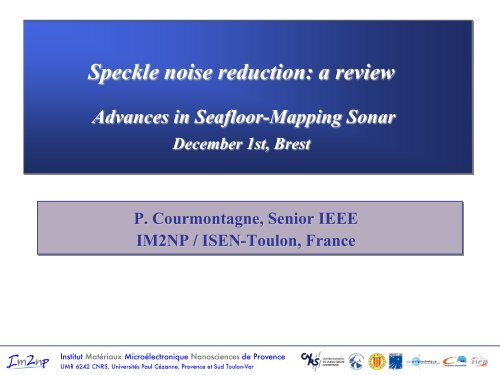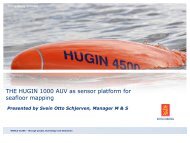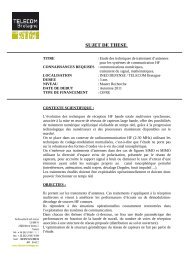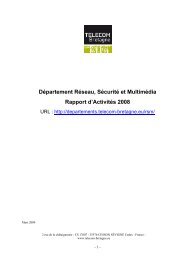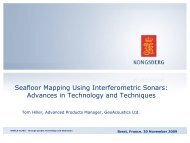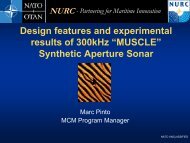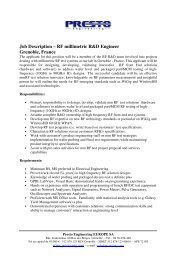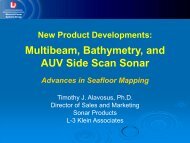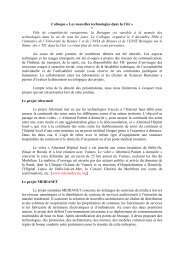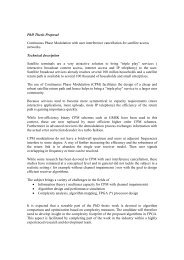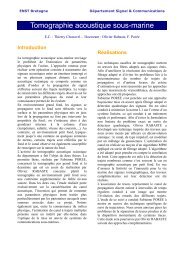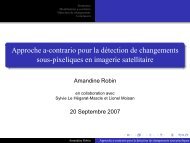Speckle noise reduction
Speckle noise reduction
Speckle noise reduction
You also want an ePaper? Increase the reach of your titles
YUMPU automatically turns print PDFs into web optimized ePapers that Google loves.
<strong>Speckle</strong> <strong>noise</strong> <strong>reduction</strong>: a review<br />
Advances in Seafloor-Mapping Sonar<br />
December 1st, Brest<br />
P. Courmontagne, Senior IEEE<br />
IM2NP / ISEN-Toulon, France
<strong>Speckle</strong> <strong>noise</strong> <strong>reduction</strong>: a review – Ph. Courmontagne<br />
2<br />
Synthetic Aperture Sonar<br />
‣ Achieve a good resolution<br />
‣ Drawback: the speckle <strong>noise</strong><br />
Granular <strong>noise</strong> that inherently exists in SAS imagery<br />
By giving a variance to the intensity of each pixel, it reduces<br />
the spatial and radiometric resolutions<br />
Avoids thin interpretation and accurate details perception<br />
<strong>Speckle</strong> <strong>noise</strong> occupies a wider dynamic range than the scene<br />
content itself<br />
Reducing the speckle <strong>noise</strong> enhances radiometric resolution at<br />
the expense of spatial resolution<br />
Compromise speckle <strong>noise</strong> <strong>reduction</strong> / spatial resolution preservation
<strong>Speckle</strong> <strong>noise</strong> <strong>reduction</strong>: a review – Ph. Courmontagne<br />
3<br />
Synthetic Aperture Sonar<br />
‣ Example of SAS data<br />
Data acquisition<br />
SHADOWS© [Jean, 2006]<br />
Sea bed (La Ciotat bay – France)<br />
Resolution: 15 cm<br />
2001 801 pixels<br />
250<br />
200<br />
150<br />
100<br />
50<br />
0<br />
SAS data
<strong>Speckle</strong> <strong>noise</strong> <strong>reduction</strong>: a review – Ph. Courmontagne<br />
4<br />
Filter Assessment methods<br />
‣ <strong>Speckle</strong> Level – Variation Coefficient<br />
Obtained by computing the variation coefficient (C in the<br />
following) for several homogeneous areas of the data.<br />
Let W be the number of homogeneous areas H n , it comes<br />
This one is computed in the same areas before and after process<br />
and allows to compute the <strong>Speckle</strong> Level <strong>reduction</strong><br />
The higher it gets, the better it is
<strong>Speckle</strong> <strong>noise</strong> <strong>reduction</strong>: a review – Ph. Courmontagne<br />
5<br />
Filter Assessment methods<br />
‣ Ratio Image [Walessa, 2000; Achim, 2005]<br />
It corresponds to the ratio of the original image (speckled) by<br />
the de-<strong>noise</strong>d image<br />
In areas of the image where the speckle is fully developed, this<br />
ratio should have the characteristics of pure speckle<br />
Any appearing edge or shape in the ratio image reveals a bad<br />
interpretation of the filter<br />
Several assessment methods are based on the ratio image<br />
Mean value (=1), equivalent number of look (SAR images);<br />
Variation coefficient, mean and speckle <strong>noise</strong> distributions
<strong>Speckle</strong> <strong>noise</strong> <strong>reduction</strong>: a review – Ph. Courmontagne 6<br />
‣ Mean filter<br />
Scalar Filters<br />
Each pixel value is replaced by the average value of its neighborhood in a<br />
M × M window<br />
The result quality is M-dependent<br />
‣ Median Filter [Pitas, 1990]<br />
Each pixel is replaced by the median of all pixels in the neighborhood in a<br />
M × M window<br />
D R D<br />
The result quality is M-dependent<br />
D R D<br />
‣ Hybrid Median Filter [Nieminen, 1986]<br />
Use a 2-way hybrid kernel<br />
<br />
Median values<br />
R R C R R<br />
D R D<br />
D R D<br />
Hybrid kernel, M=5
<strong>Speckle</strong> <strong>noise</strong> <strong>reduction</strong>: a review – Ph. Courmontagne<br />
Scalar Filters: Mean Filter (M = 5)<br />
7<br />
250<br />
200<br />
Computing Time using<br />
a Mean Filter, M=3<br />
250<br />
200<br />
Computing Time T/T 0 1.2<br />
De-<strong>noise</strong>d SAS data<br />
Variance Reduction 9.3<br />
<strong>Speckle</strong> Level Reduction<br />
4.9<br />
FOM<br />
0.62<br />
150<br />
150<br />
Ratio Image<br />
Variation Coefficient Distribution<br />
100<br />
100<br />
Standard Deviation<br />
0.95<br />
0.046<br />
Mean Distribution<br />
50<br />
50<br />
1<br />
Standard Deviation<br />
0.038<br />
De-<strong>noise</strong>d SAS data<br />
0<br />
Ratio Image<br />
0<br />
<strong>Speckle</strong> Noise Distribution<br />
Correlation Factor<br />
108
<strong>Speckle</strong> <strong>noise</strong> <strong>reduction</strong>: a review – Ph. Courmontagne<br />
8<br />
Adaptive Filters<br />
‣ Perform digital signal processing and adapt their<br />
performance based on the input signal<br />
‣ Adaptive filters appear under two forms:<br />
Summation of a weighted noisy data and the mean through the<br />
processed window<br />
performed using a sliding sub-window processing ( p,q and<br />
E{Z p,q } are computed for each window)<br />
Averaging on a part of the pixel values present in the processed<br />
window by the use of masks
<strong>Speckle</strong> <strong>noise</strong> <strong>reduction</strong>: a review – Ph. Courmontagne<br />
9<br />
‣ Henri’s filter<br />
Adaptive Filters – 1 st form<br />
Based on the local estimation of the data and <strong>noise</strong> variances<br />
‣ Lee’s filter [Lee, 1981; Lee, 1986]<br />
Signal estimation by mean square error minimization<br />
mean filter in homogeneous area, noisy data in edge area<br />
‣ Modified Lee filter [Lu, 1996]<br />
Performs a speckle <strong>noise</strong> <strong>reduction</strong> in edge area<br />
‣ Enhanced Lee filter [Lopes, 1990]<br />
The SAS image is divided in 3 classes: homogeneous (mean filter),<br />
heterogeneous (Lee’s filter) and strong heterogeneity (pixel value is<br />
preserved)
<strong>Speckle</strong> <strong>noise</strong> <strong>reduction</strong>: a review – Ph. Courmontagne<br />
10<br />
‣ Kuan filter [Kuan, 1987]<br />
Adaptive Filters – 1 st form<br />
Multiplicative <strong>noise</strong> model transforms into a signal-dependent additive <strong>noise</strong><br />
model + Minimum mean square error criterion<br />
‣ Modified Kuan filter [Lu, 1996]<br />
The Kuan filter derives from a linear approximation (1 st order Taylor<br />
expansion) Modified Kuan: the approximation is extended to 2 nd order<br />
Taylor expansion<br />
‣ Adaptive Frost filter [Frost, 1982]<br />
Equals to Wiener filter adapted to speckle model<br />
‣ Enhanced Frost filter [Lopes, 1990]<br />
Same approach as for the enhanced Lee filter
<strong>Speckle</strong> <strong>noise</strong> <strong>reduction</strong>: a review – Ph. Courmontagne<br />
Adaptive Filters – 1 st form: Enhanced Lee Filter<br />
11<br />
‣ Results (M = 7)<br />
250<br />
200<br />
250<br />
200<br />
Computing Time T/T 0 3.6<br />
De-<strong>noise</strong>d SAS data<br />
Variance Reduction 10.8<br />
<strong>Speckle</strong> Level Reduction<br />
5.9<br />
FOM<br />
0.57<br />
150<br />
150<br />
Ratio Image<br />
Variation Coefficient Distribution<br />
100<br />
100<br />
Standard Deviation<br />
0.92<br />
0.057<br />
Mean Distribution<br />
50<br />
50<br />
1<br />
Standard Deviation<br />
0.040<br />
De-<strong>noise</strong>d SAS data<br />
0<br />
Ratio Image<br />
0<br />
<strong>Speckle</strong> Noise Distribution<br />
Correlation Factor<br />
66
<strong>Speckle</strong> <strong>noise</strong> <strong>reduction</strong>: a review – Ph. Courmontagne<br />
12<br />
Adaptive Filters – 2 nd form<br />
‣ Adaptive mean filter [Pomalaza-Raez, 1984]<br />
Removes from the filtering window the pixels that have a too atypical value<br />
‣ Anisotropic diffusion filter [Perona, 1990]<br />
Diffusion process: the diffusion is isotropic in homogeneous regions and<br />
becomes anisotropic when a gradient is encountered.<br />
‣ Adaptive weighted d filter [Issa, 1996]<br />
It aims to smooth the <strong>noise</strong> and simultaneously enhance edges and preserve<br />
thin structures<br />
‣ Autoadaptive mean filter [Courmontagne, 2007]<br />
Based on the Mean Filter using for each pixel the most adequate window<br />
size, conditioned by the estimated signal first order statistics<br />
‣ Non-local mean filter [Buades, 2005]<br />
Based on the fact that images contain an extensive amount of self-similarities
<strong>Speckle</strong> <strong>noise</strong> <strong>reduction</strong>: a review – Ph. Courmontagne<br />
Adaptive Filters – 2 nd form: Autoadaptive mean filter<br />
13<br />
‣ Results (circular window, M max = 27)<br />
Computing Time T/T 0 20<br />
250<br />
200<br />
250<br />
200<br />
De-<strong>noise</strong>d SAS data<br />
Variance Reduction 14<br />
<strong>Speckle</strong> Level Reduction<br />
12<br />
FOM<br />
0.04<br />
150<br />
150<br />
Ratio Image<br />
Variation Coefficient Distribution<br />
100<br />
100<br />
Standard Deviation<br />
1.07<br />
0.074<br />
Mean Distribution<br />
50<br />
50<br />
1.03<br />
Standard Deviation<br />
0.060<br />
De-<strong>noise</strong>d SAS data<br />
0<br />
Ratio Image<br />
0<br />
<strong>Speckle</strong> Noise Distribution<br />
Correlation Factor<br />
149
<strong>Speckle</strong> <strong>noise</strong> <strong>reduction</strong>: a review – Ph. Courmontagne<br />
14<br />
‣ Principle:<br />
Adaptive Filters in Transform Domain<br />
The idea is to apply different signal decompositions to the SAS<br />
data just followed by a process adapted to the new domain<br />
Two main families of expansion<br />
Discrete Wavelet Transform (Multi-resolution analysis)<br />
Signal expansion in a weighted sum of uncorrelated<br />
random variables, where the basis depends on a priori<br />
knowledge of signal and <strong>noise</strong> statistics
<strong>Speckle</strong> <strong>noise</strong> <strong>reduction</strong>: a review – Ph. Courmontagne<br />
15<br />
Adaptive Filters in Transform Domain<br />
‣ Wavelet expansion & soft or hard thresholding<br />
The SAS data is expanded into several complementary sub-spaces (Mallat<br />
[Mallat, 1989], à Trous [Holdschneider, 1989])<br />
Only a few part of the wavelet coefficients are kept (soft and hard<br />
thresholding [Donoho, 1993])<br />
Only available for a Gaussian disturbing signal Ridgelet [Candes, 1998],<br />
Curvelet [Starck, 2002] and Gaussianisation [Mallet, 2000]<br />
‣ Stochastic Matched Filter (SMF, [Cavassilas, 1991])<br />
SAS data expansion onto a basis enhancing the SNR; signal approximation<br />
reconstruction using only a few part of the decomposition coefficients<br />
Mean square error minimization [Chaillan1, 2005], speckle <strong>noise</strong> local<br />
statistics [Courmontagne, 2007], adaptive [Courmontagne, 2006]<br />
Coupled with multi-resolution analysis: à Trous algorithm [Chaillan, 2006],<br />
Mallat algorithm [Chaillan2, 2005]
<strong>Speckle</strong> <strong>noise</strong> <strong>reduction</strong>: a review – Ph. Courmontagne<br />
Adaptive Filters in Transform Domain: ASMF<br />
16<br />
‣ Results (M max = 27, M min = 3)<br />
Computing Time T/T 0 13<br />
250<br />
200<br />
250<br />
200<br />
De-<strong>noise</strong>d SAS data<br />
Variance Reduction 17<br />
<strong>Speckle</strong> Level Reduction<br />
15<br />
FOM<br />
0.05<br />
150<br />
150<br />
Ratio Image<br />
Variation Coefficient Distribution<br />
100<br />
100<br />
Standard Deviation<br />
0.93<br />
0.062<br />
Mean Distribution<br />
50<br />
50<br />
1<br />
Standard Deviation<br />
0.063<br />
De-<strong>noise</strong>d SAS data<br />
0<br />
Ratio Image<br />
0<br />
<strong>Speckle</strong> Noise Distribution<br />
Correlation Factor<br />
58
<strong>Speckle</strong> <strong>noise</strong> <strong>reduction</strong>: a review – Ph. Courmontagne<br />
17<br />
Maximum A Posteriori (MAP) Filters<br />
‣ Using Bayesian approach, those filters intend to maximize the a<br />
posteriori probability P(S/Z)<br />
‣ Filters’ equations are derived by solving the MAP equation<br />
Assume a non-stationary multiplicative speckle <strong>noise</strong> model<br />
Too small windows introduce a bias<br />
‣ Several approaches depending on the distributions used to<br />
described the signal and P(Z/S)<br />
Kuan MAP filter [Kuan, 1987]<br />
Gamma MAP filter [Lopes, 1993]<br />
Fisher MAP filter [Nicolas, 2003]
<strong>Speckle</strong> <strong>noise</strong> <strong>reduction</strong>: a review – Ph. Courmontagne<br />
MAP Filters: Gamma MAP Filter<br />
18<br />
‣ Results (M = 9)<br />
250<br />
200<br />
250<br />
200<br />
Computing Time T/T 0 3.6<br />
De-<strong>noise</strong>d SAS data<br />
Variance Reduction 13.5<br />
<strong>Speckle</strong> Level Reduction<br />
9<br />
FOM<br />
0.49<br />
150<br />
150<br />
Ratio Image<br />
Variation Coefficient Distribution<br />
100<br />
100<br />
Standard Deviation<br />
0.95<br />
0.036<br />
Mean Distribution<br />
50<br />
50<br />
1<br />
Standard Deviation<br />
0.043<br />
De-<strong>noise</strong>d SAS data<br />
0<br />
Ratio Image<br />
0<br />
<strong>Speckle</strong> Noise Distribution<br />
Correlation Factor<br />
144
<strong>Speckle</strong> <strong>noise</strong> <strong>reduction</strong>: a review – Ph. Courmontagne<br />
19<br />
Conclusion<br />
‣ What is the best de-noising process ?<br />
Quite difficult question<br />
Depends on the use of the despeckled SAS data (detection,<br />
classification, …)<br />
Adaptive filters seem to be a good compromise<br />
‣ Other approaches<br />
Based on the use of filtering process directly on the received<br />
signals before beamforming<br />
Based on a mixing of known de-noising process
<strong>Speckle</strong> <strong>noise</strong> <strong>reduction</strong>: a review – Ph. Courmontagne<br />
20<br />
Bibliography<br />
[Jean, 2006] F. Jean, SHADOWS, by Ixsea, a real-time Synthetic Aperture Sonar system, Electronic Proceedings of OCEANS<br />
2006 - Asia Pacific, Singapore, May 2006.<br />
[Walessa, 2000] M. Walessa and M. Datcu, Model-Based Despeckling and Information Extraction from SAR Images, IEEE<br />
Transactions on Geoscience and Remote Sensing, Vol. 38 (2000), No 5, pp. 2258-2269.<br />
[Achim, 2005] A. Achim, E. Kuruoglu and J. Zerubia, SAR Image Filtering Based on the Heavy-Tailed Rayleigh Model,<br />
Research Report, INRIA, N° 5493, February 2005, FRANCE.<br />
[Pitas, 1990] I. Pitas & A.N. Venetsanopoulos, Nonlinear digital filters, Kluwer Academic Publishers, 1990<br />
[Nieminen, 1986] A. Nieminen, P. Heinonen and Y. Neuvo, 2-D Multilevel FIR-median hybrid filters, Acoustics, Speech and Signal<br />
Processing, IEEE International Conference on ICASSP’86, 11, 1986.<br />
[Lee, 1981]<br />
J.S. Lee, <strong>Speckle</strong> analysis and smoothing of synthetic aperture radar images, Computer graphics and image<br />
processing, n. 17, 1981, pp 24-32<br />
[Lee, 1986] J.S. Lee, <strong>Speckle</strong> suppression and analysis for synthetic aperture radar images, Optical engineering, vol 25 n. 5,<br />
1986, pp 636-643<br />
[Lu, 1996]<br />
Y.H. Lu, S.Y. Tan, T.S. Yeo, W.E. Ng, I. Lim and C.B. Zhang, Adaptive Filtering algorithms for SAR speckle<br />
<strong>reduction</strong>, Geoscience and Remote Sensing Symposium, IGARSS’96, 1 , 1996.<br />
[Lopes, 1990] A. Lopes, R. Touzi, E. Nezry, Adaptive speckle filters and Scene heterogeneity, IEEE Transaction on Geoscience<br />
and Remote Sensing, Vol. 28, No 6, pp. 992-1000, Nov. 1990.<br />
[Lee, 1980]<br />
J.-S. Lee, Digital image enhancement and <strong>noise</strong> filtering by use of local statistics, IEEE Transactions on Pattern<br />
Analysis and Machine Intelligence, PAMI-2, pp. 165-168, 1980.<br />
[Kuan, 1985] D. T. Kuan, A. A. Sawchuk, T. C. Strand, P. Chavel, Adaptative <strong>noise</strong> smoothing filter for images with signaldependent<br />
<strong>noise</strong>, IEEE Transactions on Pattern Analysis and Machine Intelligence, Vol. 7, No 2, pp. 165-177,<br />
March 1985.<br />
[Kuan, 1987] D. T. Kuan, A. A. Sawchuk, T. C. Strand, P. Chavel, Adaptative restoration of images with speckle, IEEE<br />
Transactions Acoustic, Speech, Signal Processing, Vol. 35, No 3, pp. 373-383, March 1987.
<strong>Speckle</strong> <strong>noise</strong> <strong>reduction</strong>: a review – Ph. Courmontagne<br />
21<br />
Bibliography<br />
[Frost, 1982] V.S. Frost, J.A. Stiles, K.S. Shanmugan, J.C. Holtzman, A model for radar images and its application to adaptive<br />
digital filtering of multiplicative <strong>noise</strong>, IEEE Trans. Pattern Analysis and Machine Intelligence, Vol. 4, No 2, pp.<br />
157-166, March 1982.<br />
[Pomalaza-Raez, 1984] C. A. Pomalaza-Raez et C. D. McGillem, An adaptive non linear edge preserving filter, IEEE Trans. on Acoustics<br />
Speech Signal Processing, Vol. 32, No3, pp. 571-576, 1984.<br />
[Perona, 1990] P. Perona and J. Malik, Scale-space and edge detection using anisotropic diffusion, IEEE Trans. On Pattern<br />
Analysis and Machine Intelligence, Vol.12 n.7, 1980, pp 629-639<br />
[Issa, 1996]<br />
I. Issa, Ph. Bolon, Adaptative weighted dalpha filter, Proc. EUSIPCO’96, Trieste, Italy, september 1996, pp.1921-<br />
1924<br />
[Courmontagne, 2007] Ph. Courmontagne, SAS images denoising: the jointly use of an autoadaptive mean filter and the stochastic<br />
matched filter, Electronic Proceedings of OCEANS’07 Aberdeen, June 2007.<br />
[Buades, 2005] A. Buades, B. Coll and J.M. Morel, A non-local algorithm for image denoising, computer Vision and Pattern<br />
Recognition, 2, 60-65, 2005<br />
[Holdschneider, 1989] M. Holdschneider, R. Kronland-Martinet, J. Morlet and P. Tchamitchian, A real time algorithm for the Signal<br />
Analysis with the help of the wavelet transform, in Wavelets. ed. J.M. Combes et al. Springer-Verlag Berlin,<br />
1989, pp.286-297.<br />
[Mallat, 1989] S. Mallat, A Theory for Multiresolution Signal Decomposition: The Wavelet Representation, Proc. IEEE Trans on<br />
Pattern Anal. and Math. intel., Vol. 11 (1989), No 7, pp. 674-693.<br />
[Donoho, 1993] D.L. Donoho and I.M. Johnstone, Adapting to unknown smoothness via wavelet shrinkage, technical report,<br />
Stanford University ([Online] Available: http://www-stat.stanford.edu/_donoho/reports.html), 1993.<br />
[Candes, 1998] E.J. Candes, Ridgelets: Theory and Applications, PhD Thesis, Stanford University, 1998<br />
[Starck, 2002] J.L. Starck, E. Candes, and D.L. Donoho, The Curvelet Transform for Image Denoising, IEEE Transactions on<br />
Image Processing , 11, 6, pp. 670-684, 2002.<br />
[Mallet, 2006] J. Mallet and P. Courmontagne, A new wavelet thresholding approach for SAS images denoising, OCEANS’06,<br />
Boston, September 2006.
<strong>Speckle</strong> <strong>noise</strong> <strong>reduction</strong>: a review – Ph. Courmontagne<br />
22<br />
Bibliography<br />
[Cavassilas, 1991] J.-F. Cavassilas, Stochastic matched filter, Proceedings of the Institute of Acoustics (International Conference on<br />
Sonar Signal Processing), Vol. 13, Part 9, pp. 194-199, 1991.<br />
[Chaillan1, 2005] F. Chaillan, C. Fraschini and Ph. Courmontagne, Stochastic matched filtering method applied to SAS imagery,<br />
OCEANS’05 Europe, Vol. 1, pp. 233-238, Brest, June 2005.<br />
[Courmontagne, 2006] Ph. Courmontagne and F. Chaillan, The Adaptive Stochastic Matched Filter for SAS images denoising,<br />
OCEANS’06, Boston, September 2006.<br />
[Chaillan, 2006] F. Chaillan and P. Courmontagne, Coupling the Stochastic Matched Filter and the à Trous Algorithm for SAS<br />
Images denoising, Electronic Proceedings of OCEANS 2006 - Asia Pacific, Singapore, May 2006.<br />
[Chaillan2, 2005] F. Chaillan, C. Fraschini, M. Amate and P. Courmontagne, Multiresolution Analysis of SAS Images, Proceedings of<br />
OCEANS 2005 - Europe, Vol. 2, pp. 1127-1132, June 2005.<br />
[Lopes, 1993] A. Lopes, E. Nezry, R. Touzi, H. Laur, Structure detection and statistical adaptive speckle filtering in SAR images,<br />
International Journal of Remote Sensing, Vol. 14, No 9, pp. 1735-1758, 1993.<br />
[Nicolas, 2003] J. M. Nicolas, A Fisher-MAP filter for SAR image processing, Proceedings of IGARSS’03, Vol. 3, pp. 1996-1998,<br />
July 2003.


